Are you thinking of adding the 1984 penny to your coin collection?
Do you already own a 1984 Lincoln Memorial cent and wonder how much it might be worth?
You’re in the right place!
The Lincoln Memorial penny series is one of the most iconic and collected coin series in American history. Abraham Lincoln’s legacy as a beloved president continues to make these coins attractive to numismatists of all levels.
While most 1984 pennies are common and worth only face value, certain mint state examples and rare errors can be worth hundreds or even thousands of dollars.
This guide covers everything you need to know about 1984 penny values, mint varieties, and key errors to watch for.
1984 Penny Value Chart
| Mint Mark | MS66 | MS67 | MS68 | MS69 |
|---|---|---|---|---|
| 1984 No-Mint Mark (Philadelphia) | $18 | $35 | $100 | $9,000 |
| 1984-D (Denver) | $15 | $38 | $285 | $15,000 |
| 1984-S Proof (San Francisco) | $5 | $6 | $7 | $16 |
Note: Coin values depend heavily on condition, color (Red, Red-Brown, Brown), and whether any errors or varieties are present. MS (Mint State) and PR (Proof) grades are assigned by professional grading services like PCGS or NGC.
The History of the 1984 Penny

The 1984 penny is part of the iconic Lincoln cent series, one of the longest-running coin series in U.S. history, first introduced in 1909 to commemorate the 100th anniversary of Abraham Lincoln’s birth.
The Origins of the Lincoln Cent
In 1905, the U.S. Mint commissioned renowned sculptor Augustus Saint-Gaudens to design new coinage, including the one-cent coin. Unfortunately, Saint-Gaudens passed away in 1907 before completing a design for the penny.
At the urging of President Theodore Roosevelt, who wanted to honor Lincoln, the Mint turned to another sculptor—Victor David Brenner. Roosevelt had previously sat for Brenner for a Panama Canal Commission medal, and impressed by his work, likely recommended him for the project.
Public support also played a role. Many citizens had written to the Treasury Department, advocating for Abraham Lincoln to be honored on a U.S. coin. With Lincoln’s 100th birthday approaching in 1909, the timing was ideal.
Brenner’s final design was approved, and the Lincoln cent was released into circulation on August 2, 1909, becoming the first U.S. coin to feature a real historical figure.
Evolution of the Lincoln Cent Design
- 1909–1958: The original reverse design featured two wheat ears (known as the Wheat Penny).
- 1959–2008: In honor of Lincoln’s 150th birthday, the reverse was changed to depict the Lincoln Memorial, designed by Frank Gasparro. This design persisted for 50 years.
- 2009: For the bicentennial of Lincoln’s birth, the U.S. Mint introduced four new reverse designs, each highlighting a different phase of Lincoln’s life.
The 1984 Lincoln penny belongs to the Memorial reverse series, struck in copper-plated zinc, a composition that began in 1982 due to the rising cost of copper.
Features of the 1984 Penny
The Obverse of the 1984 Penny
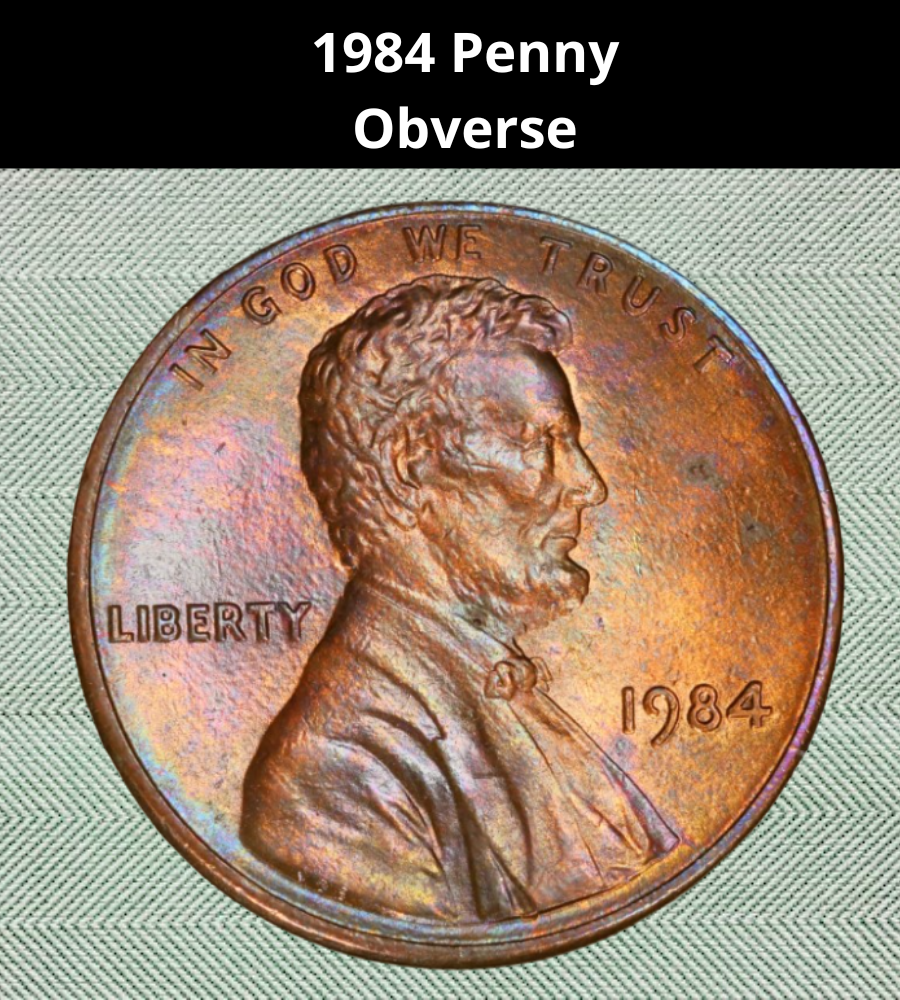
The obverse of the 1984 Lincoln Memorial penny features a right-facing bust of President Abraham Lincoln, a design created by Victor David Brenner in 1909.
Above Lincoln’s head is the national motto, IN GOD WE TRUST. To the left, behind Lincoln’s back, appears the word LIBERTY, while the year of issue, 1984, is placed to the right in front of his profile.
If minted in Denver (D) or San Francisco (S), a mint mark can be found just below the date. Coins minted in Philadelphia carry no mint mark.
This timeless design has remained largely unchanged for decades, serving as a lasting tribute to the 16th U.S. President.
The Reverse of the 1984 Penny
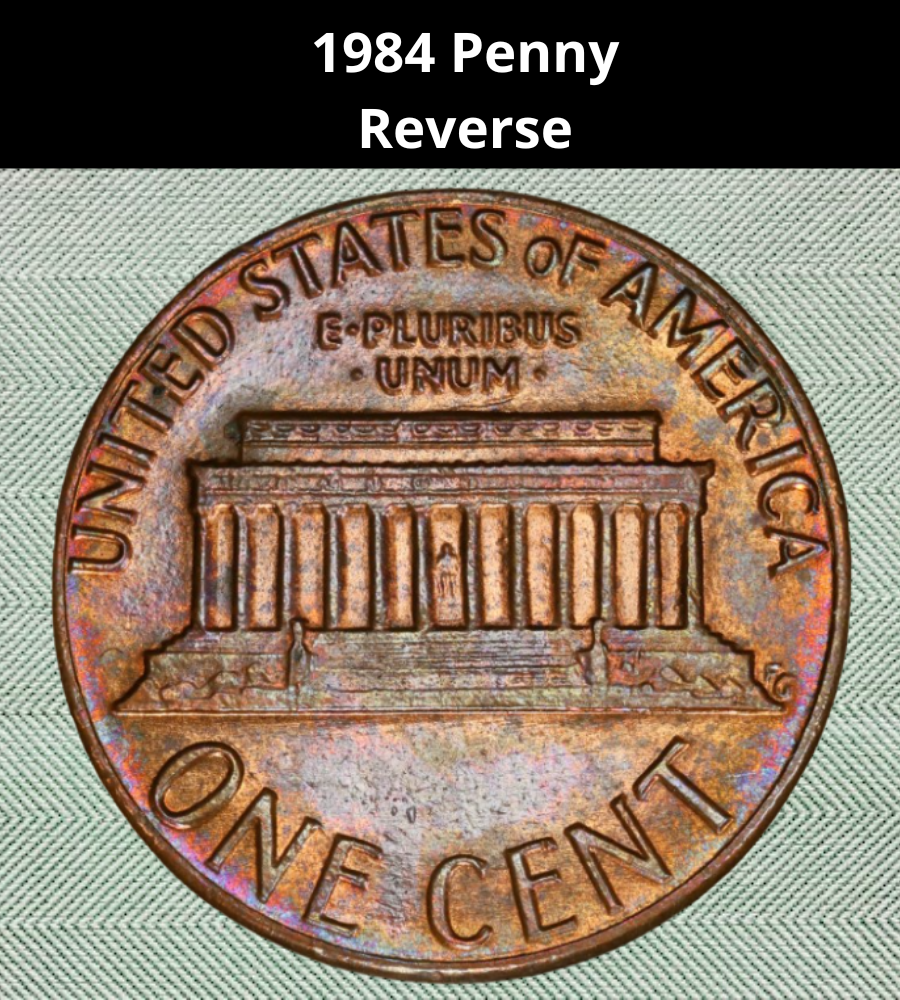
On the reverse side of the 1984 Lincoln penny, you will find the Lincoln Memorial, an iconic design created by Chief Engraver Frank Gasparro in 1959 to commemorate Abraham Lincoln’s 150th birthday.
The engraver’s initials, FG, are subtly placed next to one of the columns on the far right side of the building. Inside the Memorial, you can see a detailed depiction of Lincoln’s life-sized statue.
Along the upper edge, UNITED STATES OF AMERICA is prominently inscribed, while just below it, the motto E PLURIBUS UNUM is displayed.
At the bottom of the coin, beneath the Memorial, is the denomination: ONE CENT.
Other Features of the 1984 Penny
The 1984 Lincoln Memorial penny consists of a zinc core coated with a thin outer layer of copper. This composition change was made in response to rising copper prices since the 1960s, helping to reduce production costs.
The coin is relatively lightweight, weighing 2.5 grams and measuring 19 millimeters in diameter. It has a plain edge, typical for pennies of this era.
In 1984, pennies were struck at three U.S. Mint locations: Denver, Philadelphia, and San Francisco. Of these, only the Denver-minted coins bear a “D” mint mark located on the obverse, just below the date. Pennies from Philadelphia and San Francisco carry no mint mark or, in the case of San Francisco, are proof coins with an “S” mint mark.
1984 Penny Grading
When grading 1984 Lincoln pennies, color plays a major role. The most desirable coins are those with a bright red color, indicating they are uncirculated and typically assigned a Mint State (MS) grade. Full red pennies generally command a higher premium than coins showing brown or red-brown tones.
Condition is another critical factor. Inspect key high points for wear, including the top of Lincoln’s head, his lower jaw and earlobe, and his bow tie on the obverse side. On the reverse, examine the details on the Memorial’s steps and Lincoln’s statue inside the building for signs of wear.
Premium 1984 Lincoln Memorial cents exhibit sharp details and a strong strike on both sides. The fields (flat background areas) should have minimal scuffing or contact marks and retain a pleasing, shiny luster.
For collectors, focusing on uncirculated coins is best since circulated pennies are abundant and often show heavy wear that significantly reduces their market value.
1984 Penny Grading Scale
| Grade | Description |
|---|---|
| 1 | Basal State-1 |
| 2 | Fair |
| 3 | Very Fair |
| 4, 5, 6 | Good |
| 7, 8, 10 | Very Good |
| 12, 15 | Fine |
| 20, 30 | Very Fine |
| 40 | Extremely Fine |
| 50 | About Uncirculated |
| 60 | Mint State |
| 65 | Mint State |
| 70 | Mint State |
Check our grading guides to determine your coin’s exact scale—it’s an essential step to accurately assess your coin’s value.
1984 Penny Value Guides
1984 No-Mint Mark Penny Value
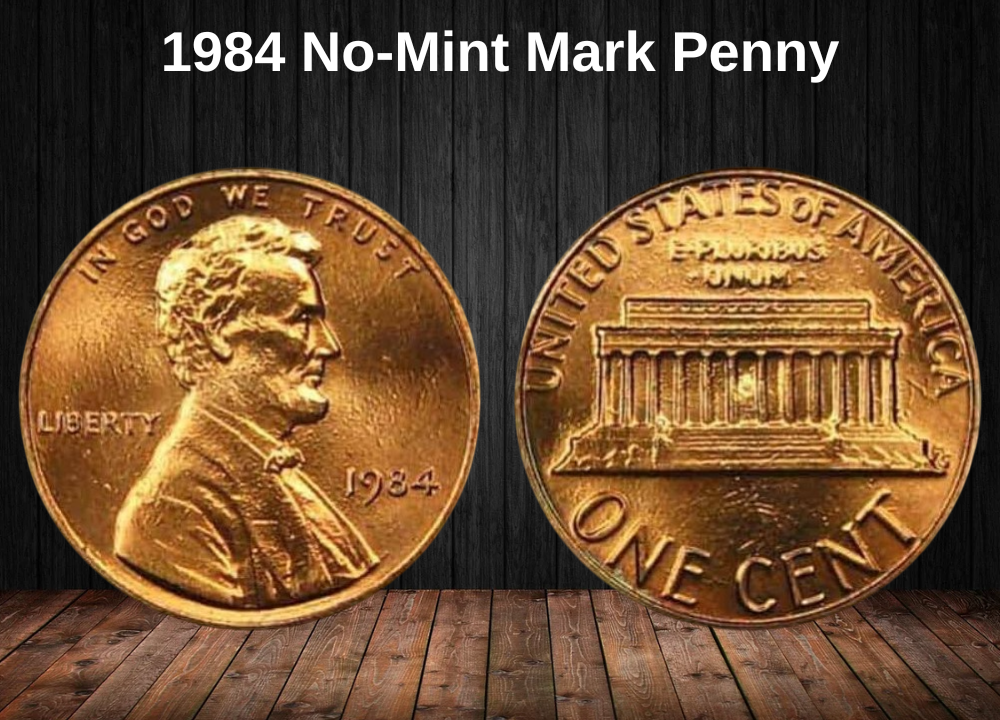
The Philadelphia Mint struck approximately 8,151,079,000 pennies in 1984. Following Mint tradition, these coins do not bear a mint mark.
With over eight billion coins produced, these pennies are extremely abundant and rank low on the rarity scale. Even though they were minted more than thirty years ago, 1984 no-mint mark pennies remain common in everyday circulation.
Because of their high availability, circulated examples typically hold very little value. For instance, a brown 1984 penny generally sells for only $4 to $5.
However, red 1984 no-mint mark pennies—usually uncirculated—can command higher prices. A red specimen graded MS68 can sell for around $100. The rarest and most valuable example recorded was a red 1984 penny graded MS69, which sold for an impressive $5,750 at auction in 2010.
1984-D Penny Value
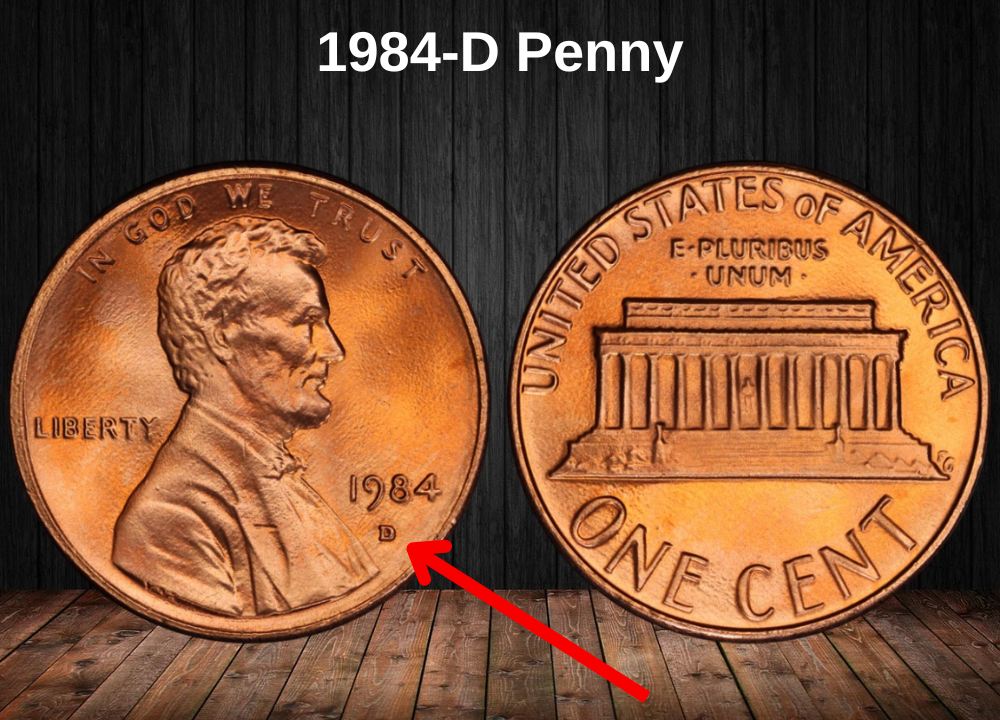
The Denver Mint struck approximately 5,569,238,906 pennies in 1984. While this mintage is lower than Philadelphia’s, it still represents a very large quantity, making these coins quite common.
Similar to the Philadelphia pennies, circulated brown 1984-D pennies typically fetch between $1 and $10.
However, in mint condition, these coins are more valuable. For example, a 1984-D penny graded MS67 can sell for around $38. Red, uncirculated specimens in the same grade may command even higher prices.
1984-S Proof Penny Value
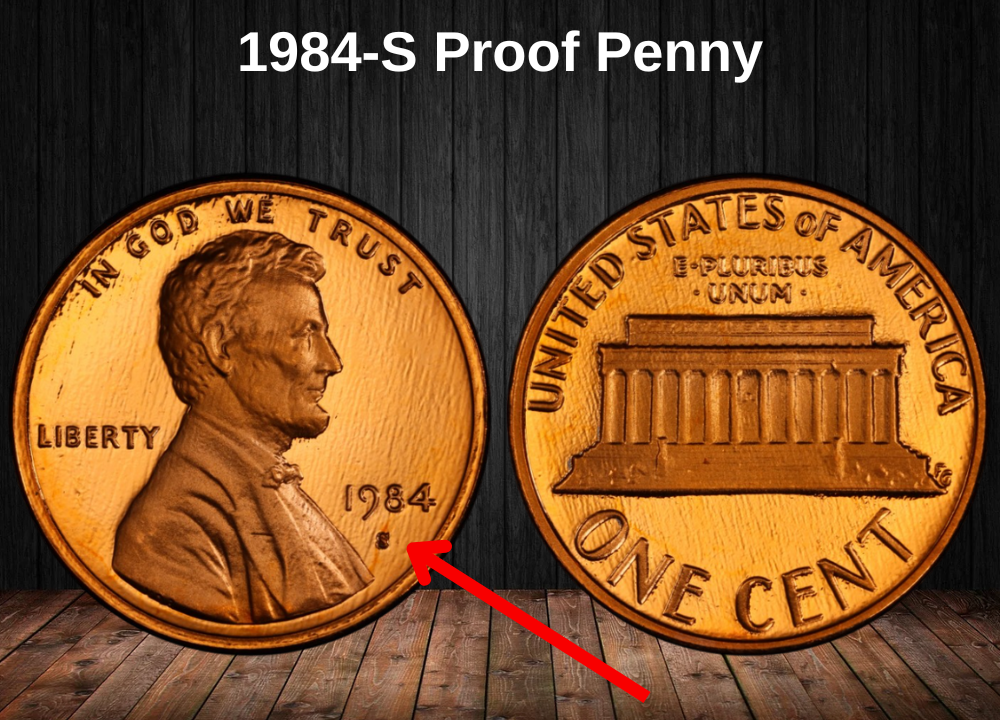
The San Francisco Mint produced an estimated 3,300,000 proof pennies in 1984. Despite the relatively low mintage and the superior strike quality compared to Philadelphia and Denver coins, the 1984-S proof penny remains relatively affordable for most grades.
There is, however, a significant price gap between various uncirculated grades. For instance:
- A red 1984-S proof penny graded PF60 is worth about $1.
- The value rises to around $4 for a coin graded PF65.
- For a deep-cameo quality proof penny graded MS70, the price can skyrocket to approximately $300.
Cameo and deep-cameo proof pennies are the most sought after by collectors. These rare coins feature a brilliant luster, frosted fields, and an exceptionally sharp strike that sets them apart from regular pennies.
The highest-priced 1984-S proof penny graded PF70 with a deep-cameo designation sold for $284 at a 2023 Heritage Auctions sale.
Rare 1984 Penny Errors List
1984 Doubled Die Obverse Penny Error
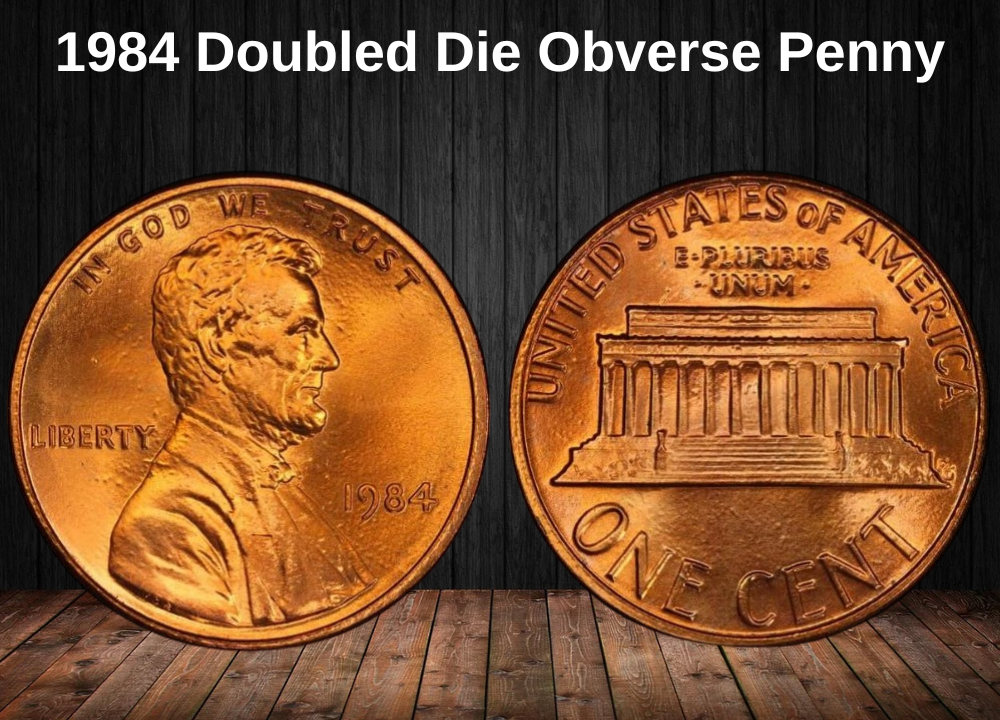
As the name suggests, a doubled die obverse error happens when the die strikes the planchet more than once at slightly different angles, causing a visible doubling of certain design elements on the coin’s face.
The 1984 doubled die obverse is one of the most popular and easily recognizable errors. The doubling is particularly noticeable on:
- Lincoln’s lower ear
- The bowtie
- The beard
Because the doubling is so distinct, these error coins attract considerable interest from collectors. There are likely several thousand 1984 DDO coins in existence.
Collectors often pay hundreds of dollars for these coins, with the most expensive specimen selling for $3,900 at a 2009 Heritage Auctions event.
1984 Double Struck Off-Center Penny Error
A double-struck off-center error occurs when a coin is struck once but fails to eject from the die, resulting in a second strike that is off-center.
This type of error is most commonly found in 1984-D Lincoln pennies and is highly sought after by collectors. While it may not reach extreme auction prices, these coins can still fetch around $100 — quite significant compared to the face value of a regular 1984 penny.
If you discover a coin with this distinctive “distorted” appearance, it’s wise to have it evaluated by a professional grading service, as it could be worth a substantial amount.
1984 Uniface Reverse Strike Penny Error
A uniface strike error happens when a blank planchet slips into the minting press and rests on top of another blank planchet between the anvil and hammer dies.
Because of this, the bottom planchet is struck only on the reverse side, leaving its obverse blank, while the top planchet is struck only on the obverse side, leaving its reverse blank.
A 1984 uniface reverse strike penny error is quite collectible and can be valued at $155 or more, depending on the coin’s condition.
1984 Rotated Die Penny Error
A rotated die error occurs when either the hammer or anvil die spins on its axis during striking, causing the two dies to be misaligned. This results in one side of the coin being struck at an incorrect angle relative to the other.
On a 1984 penny, instead of the Lincoln Memorial facing upright (northward), the image may be rotated — for example, with the roof facing northeast.
Because this error is visually obvious, rotated die pennies are popular with collectors and can command prices of $150 or more.
1984 Die Crack Penny Error

The die crack error is a relatively common occurrence among 1984-D pennies. It happens when a crack or hole forms in the die used to strike the coin. Over time, metal debris accumulates in these cracks, and when the die strikes a planchet, this dried-up metal is transferred onto the coin’s surface as a raised line or ridge.
These raised lines—called die cracks—are visible imperfections on the coin.
Depending on the severity of the crack and the coin’s overall condition, a 1984-D penny with a die crack error can be valued at up to $100.
Where to sell your penny?
Now that you know the value of your penny, you might be wondering where to sell it. Don’t worry: here’s a guide to some of the best online platforms where you can easily sell your coins, along with their advantages and disadvantages.
Discover the best platforms for selling coins online (pros and cons).
1984 Lincoln Penny – Frequently Asked Questions
1. What is the composition and weight of the 1984 penny?
The 1984 Lincoln penny is composed of 97.5% zinc with a 2.5% copper plating, weighing about 2.5 grams. This was part of the ongoing use of the copper-plated zinc planchets started in mid-1982.
2. Where were 1984 pennies minted?
In 1984, pennies were minted at three locations:
- Philadelphia (no mint mark)
- Denver (D mint mark)
- San Francisco (S mint mark) — these were proof coins only.
3. Are 1984 pennies valuable?
Most 1984 pennies are common and worth about 1 cent in circulated condition. However:
- Uncirculated coins graded MS65+ can fetch $0.50 to $5 depending on color and strike quality.
- Proof coins from San Francisco (1984-S) can be worth $1 to $10+ depending on grade.
4. Are there any notable errors or varieties for the 1984 penny?
Yes, some known varieties and errors include:
- Doubled Die Obverse (DDO) — noticeable doubling on the date and inscriptions.
- Repunched Mint Marks (RPM) — especially on Denver coins.
- Off-center strikes, die cracks, and broadstrikes.
Such error coins can be worth from $20 up to several hundred dollars based on rarity and condition.
5. How can I identify a 1984 Doubled Die Obverse penny?
Look for noticeable doubling on the date and letters on the obverse (front) side of the coin. The doubling is usually most evident on the word “LIBERTY” and the date “1984.”
6. What is the value difference between the Philadelphia and Denver minted 1984 pennies?
Generally, there is minimal value difference between Philadelphia and Denver strikes in typical circulated condition. Some collectors prefer Denver coins due to slight design or strike differences, but this rarely affects value unless the coin is uncirculated or a known error.
7. Is it worth grading my 1984 penny?
Grading is worthwhile mainly if the coin is:
- A proof 1984-S coin in high grade.
- A rare error or variety such as doubled die or RPM.
- A high-grade uncirculated specimen, especially with strong red color (RD).
Regular circulated 1984 pennies are not worth grading.


















































